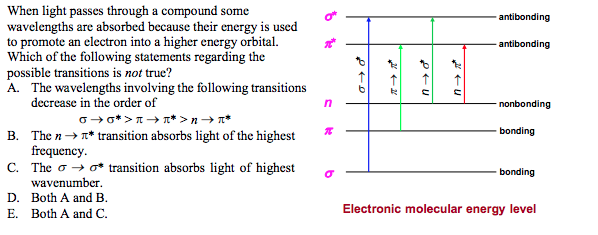When light passes through a compound some wavelengths are absorbed because their energy is used to promote an electron into a higher energy orbital. Which of the following statements regarding the possible transitions is not true? A. The wavelengths involving the following transitions decrease in the order of antibonding - antibonding nonbonding B. The n→ * transition absorbs light of the highest frequency. C. The o → o* transition absorbs light of highest bonding bonding wavenumber. D. Both A and B. E. Both A and C. Electronic molecular energy level
When light passes through a compound some wavelengths are absorbed because their energy is used to promote an electron into a higher energy orbital. Which of the following statements regarding the possible transitions is not true? A. The wavelengths involving the following transitions decrease in the order of antibonding - antibonding nonbonding B. The n→ * transition absorbs light of the highest frequency. C. The o → o* transition absorbs light of highest bonding bonding wavenumber. D. Both A and B. E. Both A and C. Electronic molecular energy level
Chemistry: Principles and Reactions
8th Edition
ISBN:9781305079373
Author:William L. Masterton, Cecile N. Hurley
Publisher:William L. Masterton, Cecile N. Hurley
Chapter6: Electronic Structure And The Periodic Table
Section: Chapter Questions
Problem 66QAP: Consider the following transitions 1. n=3 to n=1 2. n=2 to n=33. n=4 to n=34. n=3 to n=5(a) For...
Related questions
Concept explainers
Atomic Structure
The basic structure of an atom is defined as the component-level of atomic structure of an atom. Precisely speaking an atom consists of three major subatomic particles which are protons, neutrons, and electrons. Many theories have been stated for explaining the structure of an atom.
Shape of the D Orbital
Shapes of orbitals are an approximate representation of boundaries in space for finding electrons occupied in that respective orbital. D orbitals are known to have a clover leaf shape or dumbbell inside where electrons can be found.
Question

Transcribed Image Text:When light passes through a compound some
wavelengths are absorbed because their energy is used
to promote an electron into a higher energy orbital.
Which of the following statements regarding the
possible transitions is not true?
A. The wavelengths involving the following transitions
decrease in the order of
antibonding
antibonding
nonbonding
B. The n→ n* transition absorbs light of the highest
frequency.
C. The o → o* transition absorbs light of highest
wavenumber.
D. Both A and B.
bonding
bonding
E. Both A and C.
Electronic molecular energy level
Expert Solution
This question has been solved!
Explore an expertly crafted, step-by-step solution for a thorough understanding of key concepts.
Step by step
Solved in 2 steps

Knowledge Booster
Learn more about
Need a deep-dive on the concept behind this application? Look no further. Learn more about this topic, chemistry and related others by exploring similar questions and additional content below.Recommended textbooks for you

Chemistry: Principles and Reactions
Chemistry
ISBN:
9781305079373
Author:
William L. Masterton, Cecile N. Hurley
Publisher:
Cengage Learning

Chemistry
Chemistry
ISBN:
9781305957404
Author:
Steven S. Zumdahl, Susan A. Zumdahl, Donald J. DeCoste
Publisher:
Cengage Learning

Principles of Modern Chemistry
Chemistry
ISBN:
9781305079113
Author:
David W. Oxtoby, H. Pat Gillis, Laurie J. Butler
Publisher:
Cengage Learning

Chemistry: Principles and Reactions
Chemistry
ISBN:
9781305079373
Author:
William L. Masterton, Cecile N. Hurley
Publisher:
Cengage Learning

Chemistry
Chemistry
ISBN:
9781305957404
Author:
Steven S. Zumdahl, Susan A. Zumdahl, Donald J. DeCoste
Publisher:
Cengage Learning

Principles of Modern Chemistry
Chemistry
ISBN:
9781305079113
Author:
David W. Oxtoby, H. Pat Gillis, Laurie J. Butler
Publisher:
Cengage Learning

Chemistry for Engineering Students
Chemistry
ISBN:
9781337398909
Author:
Lawrence S. Brown, Tom Holme
Publisher:
Cengage Learning

Chemistry: The Molecular Science
Chemistry
ISBN:
9781285199047
Author:
John W. Moore, Conrad L. Stanitski
Publisher:
Cengage Learning

Chemistry: Principles and Practice
Chemistry
ISBN:
9780534420123
Author:
Daniel L. Reger, Scott R. Goode, David W. Ball, Edward Mercer
Publisher:
Cengage Learning